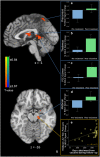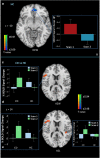Neurofunctional Reward Processing Changes in Cocaine Dependence During Recovery
- PMID: 26792441
- PMCID: PMC4908642
- DOI: 10.1038/npp.2016.11
Neurofunctional Reward Processing Changes in Cocaine Dependence During Recovery
Abstract
Although reward processing appears altered in addiction, few studies track neurofunctional changes following treatment or relate these to measures of reduced drug use. The current study examined neurofunctional alterations in reward processing in cocaine dependence (CD) pretreatment and posttreatment to determine whether these changes relate to clinically meaningful outcome indicators. Treatment-seeking CD outpatients (N=29) underwent functional magnetic resonance imaging while performing a monetary incentive delay task (MIDT) pretreatment and posttreatment. The MIDT parses anticipatory from outcome phases of reward/loss processing. Abstinence indicators (negative urines, days abstinent from cocaine during follow-up) were collected throughout treatment and up to 1 year later. Healthy control (HC) participants (N=28) were also scanned twice with the MIDT. Relative to pretreatment, at posttreatment CD participants demonstrated increased anticipatory reward activity in the midbrain, thalamus, and precuneus (pFWE<0.05). Increased midbrain activity correlated with cocaine abstinence during the 1-year follow-up. Ventral striatal (VS) activity during loss anticipation correlated negatively with negative urine screens. HC group test-retest results showed decreased ventromedial prefrontal cortex activity during winning outcomes. CD-HC group-by-time differences revealed increased left inferior frontal gyrus activity in the CD group during anticipatory phases at posttreatment. In CD participants, increased posttreatment activity in dopamine-innervated regions suggests lowered thresholds in anticipatory signaling for non-drug rewards. Midbrain and VS responses may represent biomarkers associated with CD abstinence. Abstinence-related neurobiological changes occur in similar regions implicated during active use and may possibly be used to track progress during short- and long-term recovery.
Figures



References
-
- Bari A, Robbins TW (2013). Inhibition and impulsivity: behavioral and neural basis of response control. Prog Neurobiol 108: 44–79. - PubMed
-
- Bustamante JC, Barros-Loscertales A, Costumero V, Fuentes-Claramonte P, Rosell-Negre P, Ventura-Campos N et al (2013). Abstinence duration modulates striatal functioning during monetary reward processing in cocaine patients. Addict Biol. 19: 885–894. - PubMed
Publication types
MeSH terms
Grants and funding
LinkOut - more resources
Full Text Sources
Other Literature Sources
Medical

